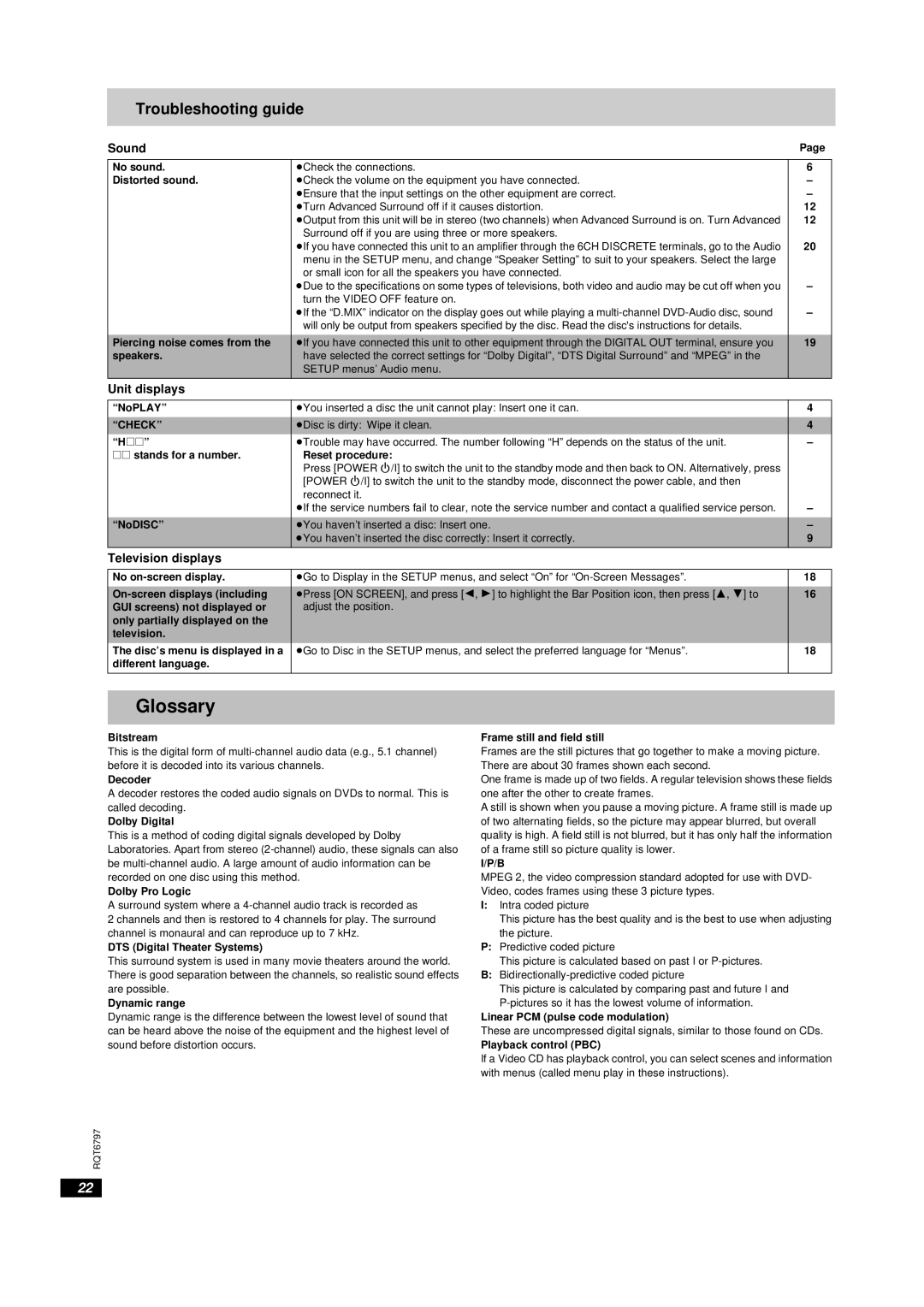
Troubleshooting guide
Sound |
| Page |
No sound. | ≥Check the connections. | 6 |
Distorted sound. | ≥Check the volume on the equipment you have connected. | – |
| ≥Ensure that the input settings on the other equipment are correct. | – |
| ≥Turn Advanced Surround off if it causes distortion. | 12 |
| ≥Output from this unit will be in stereo (two channels) when Advanced Surround is on. Turn Advanced | 12 |
| Surround off if you are using three or more speakers. |
|
| ≥If you have connected this unit to an amplifier through the 6CH DISCRETE terminals, go to the Audio | 20 |
| menu in the SETUP menu, and change “Speaker Setting” to suit to your speakers. Select the large |
|
| or small icon for all the speakers you have connected. |
|
| ≥Due to the specifications on some types of televisions, both video and audio may be cut off when you | – |
| turn the VIDEO OFF feature on. |
|
| ≥If the “D.MIX” indicator on the display goes out while playing a | – |
| will only be output from speakers specified by the disc. Read the disc's instructions for details. |
|
|
|
|
Piercing noise comes from the | ≥If you have connected this unit to other equipment through the DIGITAL OUT terminal, ensure you | 19 |
speakers. | have selected the correct settings for “Dolby Digital”, “DTS Digital Surround” and “MPEG” in the |
|
| SETUP menus’ Audio menu. |
|
Unit displays |
|
|
|
|
|
“NoPLAY” | ≥You inserted a disc the unit cannot play: Insert one it can. | 4 |
|
|
|
“CHECK” | ≥Disc is dirty: Wipe it clean. | 4 |
“H∑∑” | ≥Trouble may have occurred. The number following “H” depends on the status of the unit. | – |
∑∑ stands for a number. | Reset procedure: |
|
| Press [POWER Í/I] to switch the unit to the standby mode and then back to ON. Alternatively, press |
|
| [POWER Í/I] to switch the unit to the standby mode, disconnect the power cable, and then |
|
| reconnect it. |
|
| ≥If the service numbers fail to clear, note the service number and contact a qualified service person. | – |
|
|
|
“NoDISC” | ≥You haven’t inserted a disc: Insert one. | – |
| ≥You haven’t inserted the disc correctly: Insert it correctly. | 9 |
Television displays |
|
|
|
|
|
No | ≥Go to Display in the SETUP menus, and select “On” for | 18 |
|
|
|
≥Press [ON SCREEN], and press [2, 1] to highlight the Bar Position icon, then press [3, 4] to | 16 | |
GUI screens) not displayed or | adjust the position. |
|
only partially displayed on the |
|
|
television. |
|
|
The disc’s menu is displayed in a | ≥Go to Disc in the SETUP menus, and select the preferred language for “Menus”. | 18 |
different language. |
|
|
|
|
|
Glossary
Bitstream
This is the digital form of
Decoder
A decoder restores the coded audio signals on DVDs to normal. This is called decoding.
Dolby Digital
This is a method of coding digital signals developed by Dolby Laboratories. Apart from stereo
Dolby Pro Logic
A surround system where a
2 channels and then is restored to 4 channels for play. The surround channel is monaural and can reproduce up to 7 kHz.
DTS (Digital Theater Systems)
This surround system is used in many movie theaters around the world. There is good separation between the channels, so realistic sound effects are possible.
Dynamic range
Dynamic range is the difference between the lowest level of sound that can be heard above the noise of the equipment and the highest level of sound before distortion occurs.
Frame still and field still
Frames are the still pictures that go together to make a moving picture. There are about 30 frames shown each second.
One frame is made up of two fields. A regular television shows these fields one after the other to create frames.
A still is shown when you pause a moving picture. A frame still is made up of two alternating fields, so the picture may appear blurred, but overall quality is high. A field still is not blurred, but it has only half the information of a frame still so picture quality is lower.
I/P/B
MPEG 2, the video compression standard adopted for use with DVD- Video, codes frames using these 3 picture types.
I:Intra coded picture
This picture has the best quality and is the best to use when adjusting
the picture.
P:Predictive coded picture
This picture is calculated based on past I or
B:
This picture is calculated by comparing past and future I and
Linear PCM (pulse code modulation)
These are uncompressed digital signals, similar to those found on CDs.
Playback control (PBC)
If a Video CD has playback control, you can select scenes and information with menus (called menu play in these instructions).
RQT6797
22
